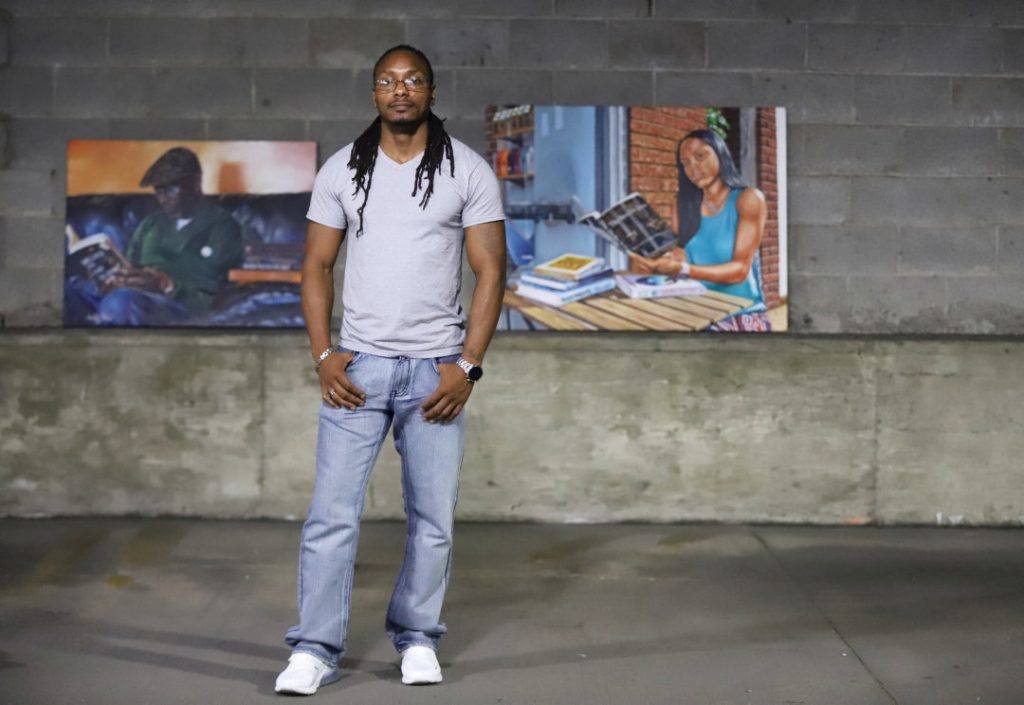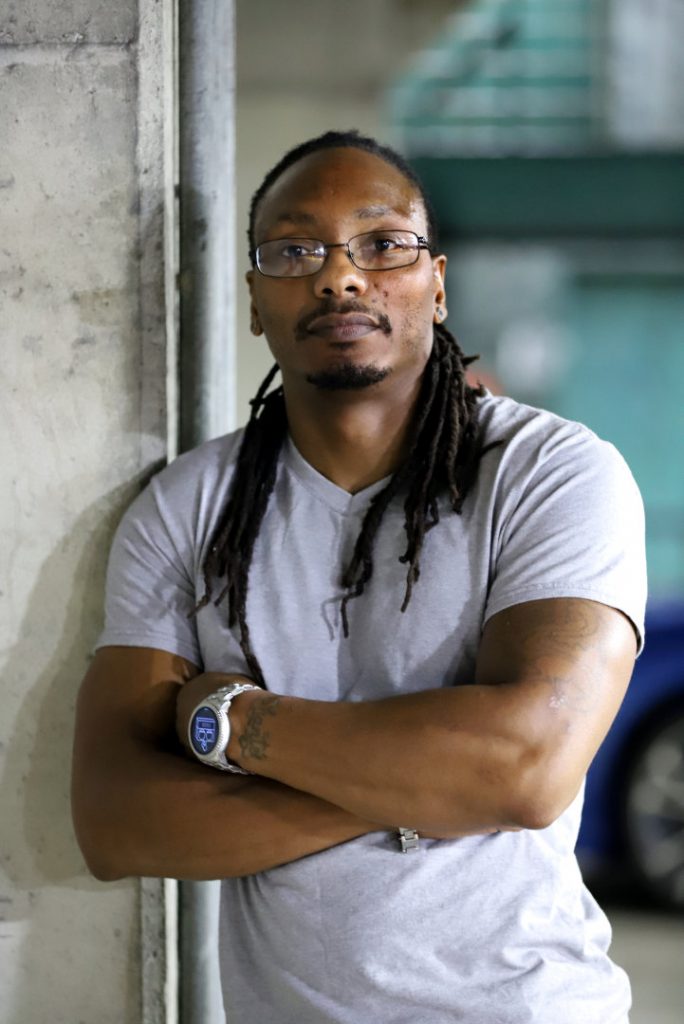Growing up in the south, the challenges Travis Prince faced made him want to create change. A graduate of Mayo High School for Math, Science & Technology in Darlington, South Carolina, he made it his mission to give a voice to the black community after finishing high school. He moved to Scranton roughly eight years ago and is now a program assistant at Outreach Scranton. Over the last eight 10 years, he has dedicated himself to improving as a painter in order to pay homage to a special mentor in his life. He lives in Wilkes-Barre.
What brought you from South Carolina to Scranton?
It was basically the housing crash in 2008. I was working a construction job for about seven or eight years. We had one major contractor and when the market went down in 2008, our biggest contractor stopped building and we got laid off. I was on unemployment for a while, but I wound up moving to Virginia for a few years. After living in Virginia for almost three years, I heard about a job in Scranton. It was an electrician job on Adams Avenue. I was commuting from Virginia. After working the job for five or six months, I ended up meeting a young lady and moved here.
What is your art background and what made you want to pursue it?
I tell most people for the most part, I’m self taught because I didn’t go to university or college to study it. I had a really good art teacher, even in grade school. She loved art and really wanted to teach it. She taught me a lot. For high school, I transferred school districts, and my art teacher actually applied and got a job there as well. So my first year in high school, I had the same art teacher I did in middle school, and she taught me for six years. After high school, I didn’t create anything for almost 10 years. One day I had the urge to create again; it was almost like an epiphany. I got home one afternoon, completely bored, I had video games, I had a car, my own place, friends, and nothing seemed to entice me or motivate me. I thought I hadn’t drawn in a long time, so I went to the art supply store. I saw canvasses, got a Bob Ross starter paint kit, came home and did a painting. I thought it was pretty good, so I continued painting from that point on and haven’t been bored since.
What other art lessons did you take?
Once I got to Virginia, in Fredericksburg, I found the Liberty Town Art Workshop and Gallery. I came across an artist, William Harris, everybody calls him Bill, and his work is amazing. I told him I was an artist and he asked to see some of my work. He told me he gives classes and he could show me a different way of painting. He told me to come sit in on one of his classes and observe. If I liked it, I could participate. He immediately put a canvas in front of me. At the end of class, he said “see you next week.” By the third week, I could tell I was learning from him and he was really helping me through critiques. I wanted to join the class but didn’t want to get behind in payments. He said “Travis, I do pretty well as an artist, my classes are always full, if I have one or two students who can’t afford to pay for classes, it doesn’t bother me. I’m not going to charge you for lessons, but the way you can repay me is you can’t stop painting. Continue to create art to pay me back.” I was mentored by him for two years, but in the two years, he advanced my art technique 10 years. I still feel like I need to grow as an artist to honor him and express my appreciation for what he taught me.
 What specific messages do you hope to share through your artwork?
What specific messages do you hope to share through your artwork?
The main thing I want people to take away from my art is that the average African-American is just as beautiful, just as talented and just as intelligent as anyone else. I want to heighten and elevate that idea.
Why is being an advocate for this important to you?
The high school I went to, everything was college prep. As a teenager I felt I was receiving above and beyond the average high school student’s education. Years after my high school education, I went on a selective reading course for myself. After reading African-American authors, historians and journalists, I realized my education was pretty bad. I’ve always loved to read and when I was reading Oliver Twist, a Tale of Two Cities, The Great Gatsby or Lord of the Flies, I realized they were all Eurocentric stories with European characters that I couldn’t relate to. In my education, no one ever asked me to read Malcom X or Dr. King. I wondered why so much was left out of the curriculum when the African-American history and experience spans centuries in this country.
What artists or subjects inspire your artwork?
One of my favorite artists is Norman Rockwell. I really try to emulate his technical style and his visual style in that he made the average person look important; the average family having dinner and he made it in this grand way; or kids walking to school or a kid and his dog jumping in a lake. It gives you such a feel of nostalgia and connection with these pieces of ordinary people. I really try to do that with my art. We all add to the human story and I don’t think you need to be a celebrity or a household name to be immortalized on a canvas. I try to paint the average person in a respectable and dignified light. The core foundation of my art is everyday people are important, everyday people are beautiful, we all add to the human story. From there, I try to encompass the black experience. Just in general in American pop culture, the black image is not as prevalent in mainstream art in galleries or museums. I purposely make an attempt to fill that gap. So my art focuses on the average person in the black community, the average American in general, then I try to do an overlay of education in my art as well. I felt like implementing literature into my art is an advantage for the viewers to see a whole facet of names; so you have the black image, the average person and you have this overlay of literature as well.
Can you expand on the educational aspect of your art?
Once I started my selective reading process, it was a snowball effect where I read one work and the author made references to another author’s work and so I read that. This author talks about this author and I came across a wealth of information that is just there and I didn’t know about it. Every book I’ve read, I’ve painted it in my artwork. Once people see my reader series, and see the authors and literature [references] that they are completely unaware of, they are kind of taken aback. I feel like I have a talent in understanding about the lack of education. I hope to, again, kind of fill that gap and squeeze something educational into my art, even if it’s just a book title.One of the greatest joys is the random emails or messages from people who said they saw a book in my painting, read it and it was awesome. To be able to help someone go on an intellectual quest for themselves and to read something outside of their norm is a positive thing and I really want to continue doing that.
You’ve had many local shows and collaborated with other local artists, which has been the most memorable for you and why?
I did a show at the Abington Community Library in February. My reader series, in each painting, is someone reading a book. There are usually 14 pieces in a reader series, but I don’t often get to show that many together. It’s usually two or three paintings. I had a solo exhibit at the Abington library and I was able to show 12 pieces of the reader series in a library. It’s the perfect place for a series on books. I thought that went really well and it had a lot of positive feedback. It’s in a library, so you’re around people who love and care about books. On top of that, I was able to educate people, because the books in my art aren’t in a library or on the shelves at bookstores. For these people who love books and literature, to be exposed to literature that they’re not aware of, then tell me they went and got the book is really cool.
What other hobbies and interests do you have or organizations are you part of?
I’ve been a member of AFA since 2013. AFA was the first gallery in Scranton that gave me a large show. I’m a member of the Wyoming Valley Arts League. I’m also a board member for the Black Scranton Project. Glynis Johns is the founder of the Black Scranton Project and she is such a talented powerhouse. She is going to be living in New Jersey this fall as she works toward a Ph.D, and this project is her baby. So it will up be to the board members to continue the project and make sure everything is in order in her absence. I’m working on a television show for Electric City TV called Round Table Discussions. I’m the host of the show and will bring in other local artists to display their artwork and talk about their creative process. I like writing poetry. This year I was part of the Keystone Iron Works and helped high school students make molds out of clay then we went to the Iron Furnaces and poured hot iron in them. That is something I want to continue; it’s a new hobby for me. I hate to say video games are a hobby, but I’m really into video games. I think every aspect of video games is artistic, from the level design, set design, character design and color palettes all have to come from the artist. My main thing is my art; it’s such a passion. I paint everyday. I have a big in-house studio and that’s where I’m really focusing myself right now. It took me nine years, but now this year is the first year I haven’t had to reach out and ask venues if I could show my art. People are coming to me to ask if I will show my art, and I feel like the next 10 years will just get better.
What has been the most motivational event or advice you’ve received in life personally or as an artist?
I would have to attribute all my of success to Bill. Without his motivation and encouragement, I probably would have stopped years ago. Just by having one individual see my potential and have a bigger vision for me than I had for myself, that is probably the most pivotal things to happen to me in my art career. Just the fact that he believed in me enough to give me free art lessons.

Emma Black is a photographer and writes Up Close and Personal, which spotlights people from all walks of life in NEPA who have a unique skill, craft, talent or trade. She is a graduate of Abington Heights High School and University of Scranton, where she studied journalism and electronic media. Emma has been with Times-Shamrock Communications since 2016 and enjoys playing, coaching and following soccer; exploring international cuisine; and doing arts and crafts in her free time. Contact: eblack@timesshamrock.com; 570-348-9100; @emmablack_13






